2010 PEUGEOT 3008 towing
[x] Cancel search: towingPage 56 of 315

56
The air conditioning system
does not contain chlorine and
does not present any danger
to the ozone layer. RECOMMENDATIONS FOR VENTILATION AND AIR CONDITIONING
In order for these systems to be fully effective, follow the operation and
maintenance guidelines below:
� If the interior temperature remains very high aft er the vehicle has been parked
�i�n� �t�h�e� �s�u�n� �f�o�r� �a� �c�o�n�s�i�d�e�r�a�b�l�e� �t�i�m�e�,� �fi� �r�s�t� �v�e�n�t�i�l�a�t�e � �t�h�e� �p�a�s�s�e�n�g�e�r� �c�o�m�p�a�r�t�m�e�n�t�
for a few minutes.
� �P�l�a�c�e� �t�h�e� �a�i�r� �fl� �o�w� �c�o�n�t�r�o�l� �a�t� �a� �s�u�f�fi� �c�i�e�n�t� �l�e�v�e�l� �t�o� �p�r�o�v�i�d�e� �a�n� �a�d�e�q�u�a�t�e� �r�e�n�e�w�a�l�
of air in the passenger compartment.
� To obtain an even air distribution, take care not to obst ruct the exterior air
intake grilles located at the base of the windscreen, the n ozzles, the vents
and the air outlets, as well as the air extractor located in the boot.
� Use in preference the intake of exterior air as prolonged use of the air recir-
culation may cause misting of the windows and side windows.
� Do not cover the sunshine sensor, located on the dashboard; this is used for
regulation of the automatic air conditioning system.
� Operate the air conditioning system for 5 to 10 minutes, on ce or twice a
month to keep it in perfect working order.
� � � �E�n�s�u�r�e� �t�h�a�t� �t�h�e� �p�a�s�s�e�n�g�e�r� �c�o�m�p�a�r�t�m�e�n�t� �fi� �l�t�e�r� �i�s� �i�n� �g�o�o�d� �c�o�n�d�i�t �i�o�n� �a�n�d� �h�a�v�e�
�t�h�e� �fi� �l�t�e�r� �e�l�e�m�e�n�t�s� �r�e�p�l�a�c�e�d� �r�e�g�u�l�a�r�l�y� �(�r�e�f�e�r� �t�o� �t�h�e� �"�C�h�e�c�k�s�"� �s�e�c�t�i�o �n�)�.� �
� �W�e� �r�e�c�o�m�m�e�n�d� �t�h�e� �u�s�e� �o�f� �a� �c�o�m�b�i�n�e�d� �p�a�s�s�e�n�g�e�r� �c�o�m�p�a�r�t�m�e�n�t� �fi� �l�t�e�r�. � �T�h�a�n�k�s�
�t�o� �i�t�s� �s�e�c�o�n�d� �s�p�e�c�i�a�l� �a�c�t�i�v�e� �fi� �l�t�e�r�,� �i�t� �c�o�n�t�r�i�b�u�t�e�s� �t�o� �t�h�e� �p�u �r�i�fi� �c�a�t�i�o�n� �o�f� �t�h�e� �a�i�r�
breathed by the occupants and the cleanliness of the passenge r compart-
�m�e�n�t� �(�r�e�d�u�c�t�i�o�n� �o�f� �a�l�l�e�r�g�i�c� �s�y�m�p�t�o�m�s�,� �b�a�d� �o�d�o�u�r�s� �a�n�d� �g�r�e�a�s�y� �d�e�p�o�s�i�t �s�)�.�
� To ensure correct operation of the air conditioning system, you are also ad-
vised to have it checked regularly.
� If the system does not produce cold air, do not use it and contact a PEUGEOT
dealer.
When towing the maximum load on a steep gradient in high temperatures,
switching off the air conditioning saves engine power and i mproves towing ca-
pacity.
The condensation created by the air conditioning results in a discharge of water
under the vehicle which is perfectly normal.
Page 119 of 315
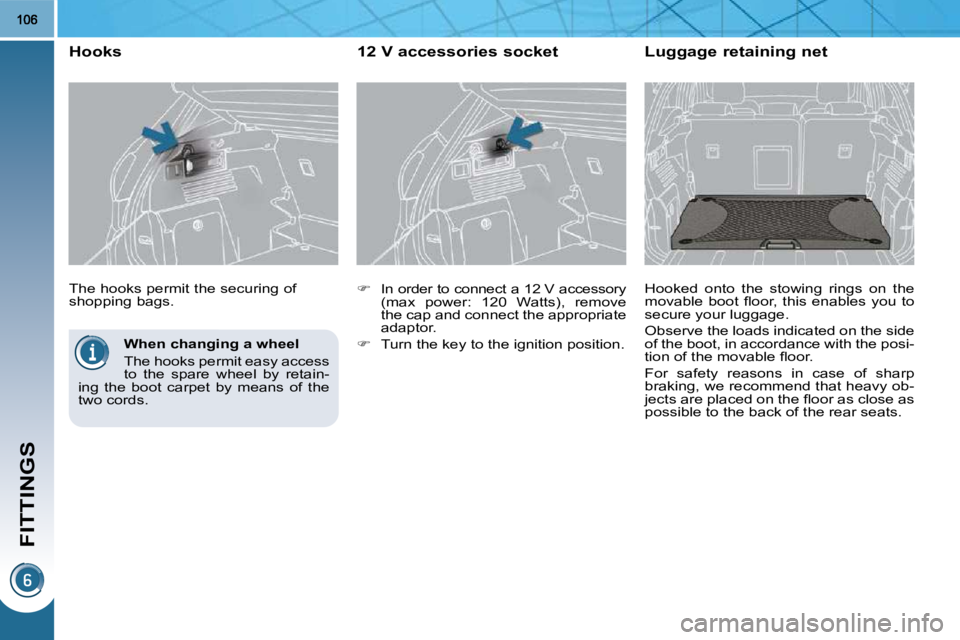
FITTINGS
When changing a wheel
The hooks permit easy access
to the spare wheel by retain-
ing the boot carpet by means of the
two cords.
The hooks permit the securing of
shopping bags.
Hooks
� In order to connect a 12 V accessory
(max power: 120 Watts), remove
the cap and connect the appropriate
adaptor.
� Turn the key to the ignition position.
12 V accessories socket Luggage retaining net
Hooked onto the stowing rings on the
�m�o�v�a�b�l�e� �b�o�o�t� �fl� �o�o�r�,� �t�h�i�s� �e�n�a�b�l�e�s� �y�o�u� �t�o�
secure your luggage.
Observe the loads indicated on the side
of the boot, in accordance with the posi-
�t�i�o�n� �o�f� �t�h�e� �m�o�v�a�b�l�e� �fl� �o�o�r�.�
For safety reasons in case of sharp
braking, we recommend that heavy ob-
�j�e�c�t�s� �a�r�e� �p�l�a�c�e�d� �o�n� �t�h�e� �fl� �o�o�r� �a�s� �c�l�o�s�e� �a�s�
possible to the back of the rear seats.
Page 124 of 315
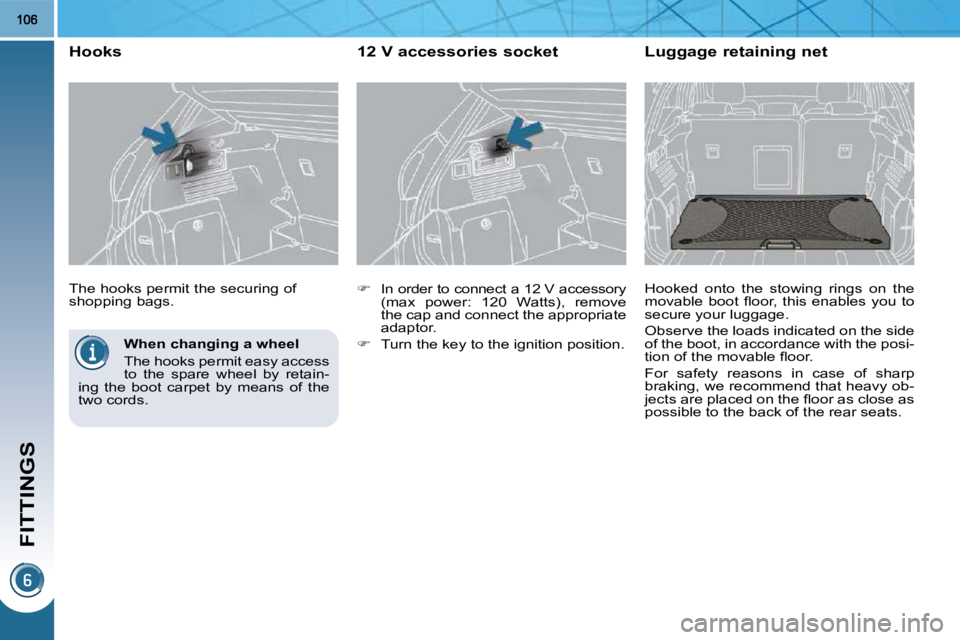
FITTINGS
When changing a wheel
The hooks permit easy access
to the spare wheel by retain-
ing the boot carpet by means of the
two cords.
The hooks permit the securing of
shopping bags.
Hooks
� In order to connect a 12 V accessory
(max power: 120 Watts), remove
the cap and connect the appropriate
adaptor.
� Turn the key to the ignition position.
12 V accessories socket Luggage retaining net
Hooked onto the stowing rings on the
�m�o�v�a�b�l�e� �b�o�o�t� �fl� �o�o�r�,� �t�h�i�s� �e�n�a�b�l�e�s� �y�o�u� �t�o�
secure your luggage.
Observe the loads indicated on the side
of the boot, in accordance with the posi-
�t�i�o�n� �o�f� �t�h�e� �m�o�v�a�b�l�e� �fl� �o�o�r�.�
For safety reasons in case of sharp
braking, we recommend that heavy ob-
�j�e�c�t�s� �a�r�e� �p�l�a�c�e�d� �o�n� �t�h�e� �fl� �o�o�r� �a�s� �c�l�o�s�e� �a�s�
possible to the back of the rear seats.
Page 137 of 315
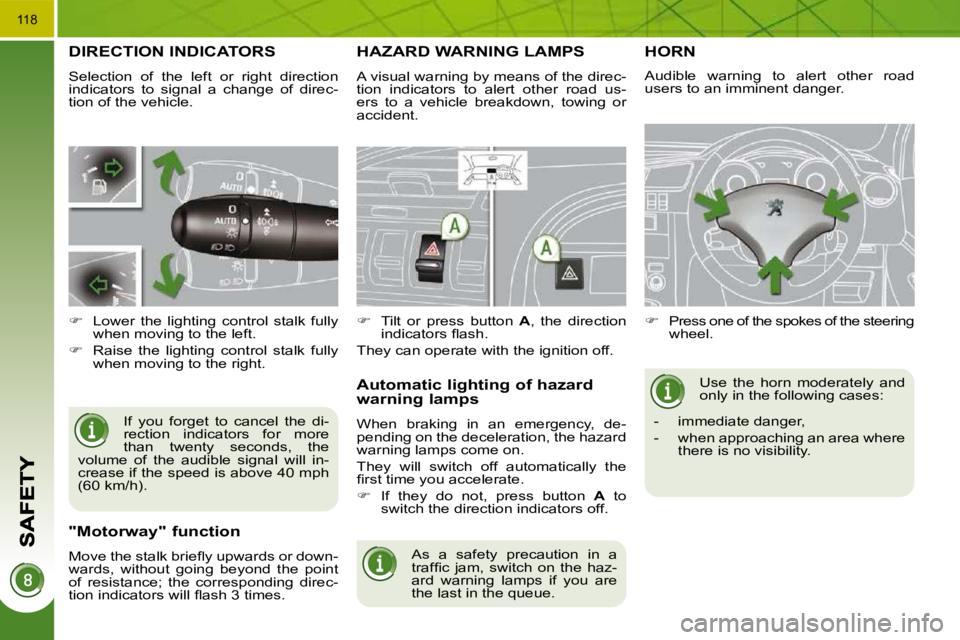
118
DIRECTION INDICATORS
Selection of the left or right direction
indicators to signal a change of direc-
tion of the vehicle. If you forget to cancel the di-
rection indicators for more
than twenty seconds, the
volume of the audible signal will in-
crease if the speed is above 40 mph
(60 km/h).
� Lower the lighting control stalk fully
when moving to the left.
� Raise the lighting control stalk fully
when moving to the right.
HAZARD WARNING LAMPS
A visual warning by means of the direc-
tion indicators to alert other road us-
ers to a vehicle breakdown, towing or
accident.
As a safety precaution in a
�t�r�a�f�fi� �c� �j�a�m�,� �s�w�i�t�c�h� �o�n� �t�h�e� �h�a�z�-
ard warning lamps if you are
the last in the queue.
� Tilt or press button A , the direction
�i�n�d�i�c�a�t�o�r�s� �fl� �a�s�h�.� �
They can operate with the ignition off.
Automatic lighting of hazard warning lamps
When braking in an emergency, de-
�p�e�n�d�i�n�g� �o�n� �t�h�e� �d�e�c�e�l�e�r�a�t�i�o�n�,� �t�h�e� �h�a�z�a�r�d�
warning lamps come on.
They will switch off automatically the
�fi� �r�s�t� �t�i�m�e� �y�o�u� �a�c�c�e�l�e�r�a�t�e�.�
� If they do not, press button A to
switch the direction indicators off.
HORN
� Press one of the spokes of the steering
wheel.
Use the horn moderately and
only in the following cases:
- immediate danger,
- when approaching an area where there is no visibility.
Audible warning to alert other road
users to an imminent danger.
"Motorway" function
� �M�o�v�e� �t�h�e� �s�t�a�l�k� �b�r�i�e�fl� �y� �u�p�w�a�r�d�s� �o�r� �d�o�w�n�-
wards, without going beyond the point
of resistance; the corresponding direc-
�t�i�o�n� �i�n�d�i�c�a�t�o�r�s� �w�i�l�l� �fl� �a�s�h� �3� �t�i�m�e�s�.� �
Page 152 of 315
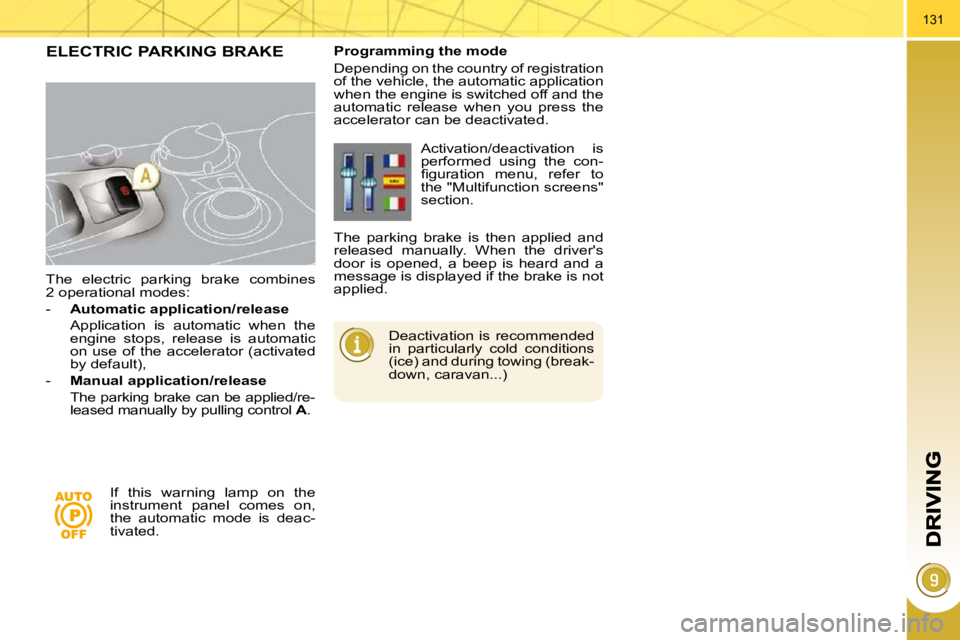
131
The electric parking brake combines
2 operational modes:
- Automatic application/release
Application is automatic when the engine stops, release is automatic
on use of the accelerator (activated
by default),
- Manual application/release
The parking brake can be applied/re- leased manually by pulling control A .
ELECTRIC PARKING BRAKE
Deactivation is recommended
in particularly cold conditions
(ice) and during towing (break-
down, caravan...)
Programming the mode
Depending on the country of registration
of the vehicle, the automatic application
when the engine is switched off and the
automatic release when you press the
accelerator can be deactivated.
If this warning lamp on the
instrument panel comes on,
the automatic mode is deac-
tivated. Activation/deactivation is
performed using the con-
�fi� �g�u�r�a�t�i�o�n� �m�e�n�u�,� �r�e�f�e�r� �t�o�
the "Multifunction screens"
section.
The parking brake is then applied and
released manually. When the driver's
door is opened, a beep is heard and a
message is displayed if the brake is not
applied.
Page 153 of 315
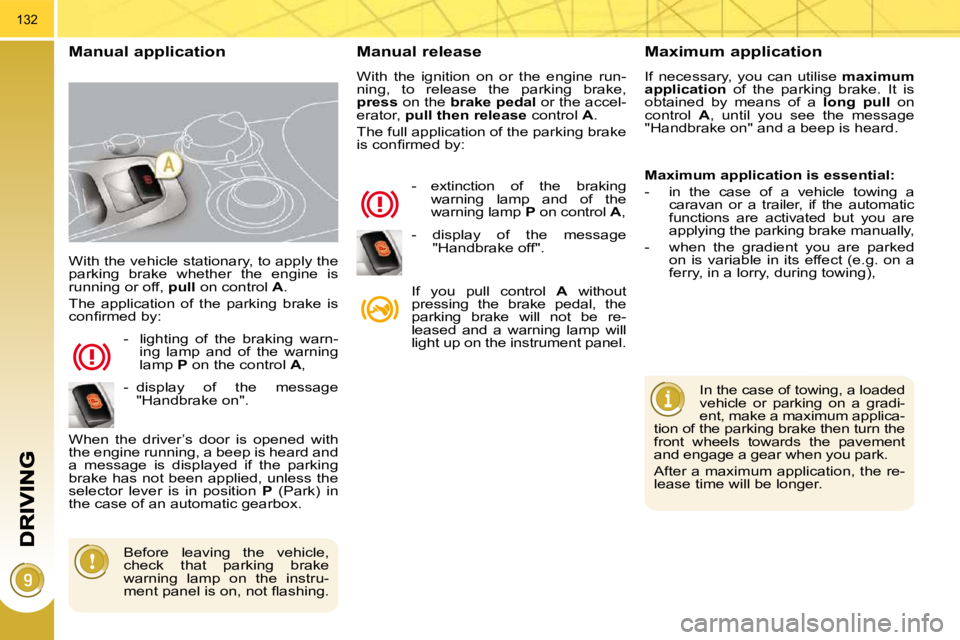
132
With the vehicle stationary, to apply the
parking brake whether the engine is
running or off, pull on control A .
The application of the parking brake is
�c�o�n�fi� �r�m�e�d� �b�y�:�
- lighting of the braking warn-ing lamp and of the warning
lamp P on the control A ,
When the driver’s door is opened with
the engine running, a beep is heard and
a message is displayed if the parking
brake has not been applied, unless the
selector lever is in position P (Park) in
the case of an automatic gearbox.
Manual release
With the ignition on or the engine run-
ning, to release the parking brake,
press on the brake
pedal or the accel-
erator, pull then release control A .
The full application of the parking brake
�i�s� �c�o�n�fi� �r�m�e�d� �b�y�:�
- extinction of the braking warning lamp and of the
warning lamp P on control A ,
If you pull control A without
pressing the brake pedal, the
parking brake will not be re-
leased and a warning lamp will
light up on the instrument panel.
Manual application Maximum application
If necessary, you can utilise maximum
application of the parking brake. It is
obtained by means of a long pull on
control A , until you see the message
"Handbrake on" and a beep is heard.
In the case of towing, a loaded
vehicle or parking on a gradi-
ent, make a maximum applica-
tion of the parking brake then turn the
front wheels towards the pavement
and engage a gear when you park.
After a maximum application, the re-
lease time will be longer.
Before leaving the vehicle,
check that parking brake
warning lamp on the instru-
�m�e�n�t� �p�a�n�e�l� �i�s� �o�n�,� �n�o�t� �fl� �a�s�h�i�n�g�.� � �
Maximum application is essential:
- in the case of a vehicle towing a caravan or a trailer, if the automatic
functions are activated but you are
applying the parking brake manually,
- when the gradient you are parked on is variable in its effect (e.g. on a
ferry, in a lorry, during towing),
- display of the message "Handbrake on". - display of the message
"Handbrake off".
Page 154 of 315
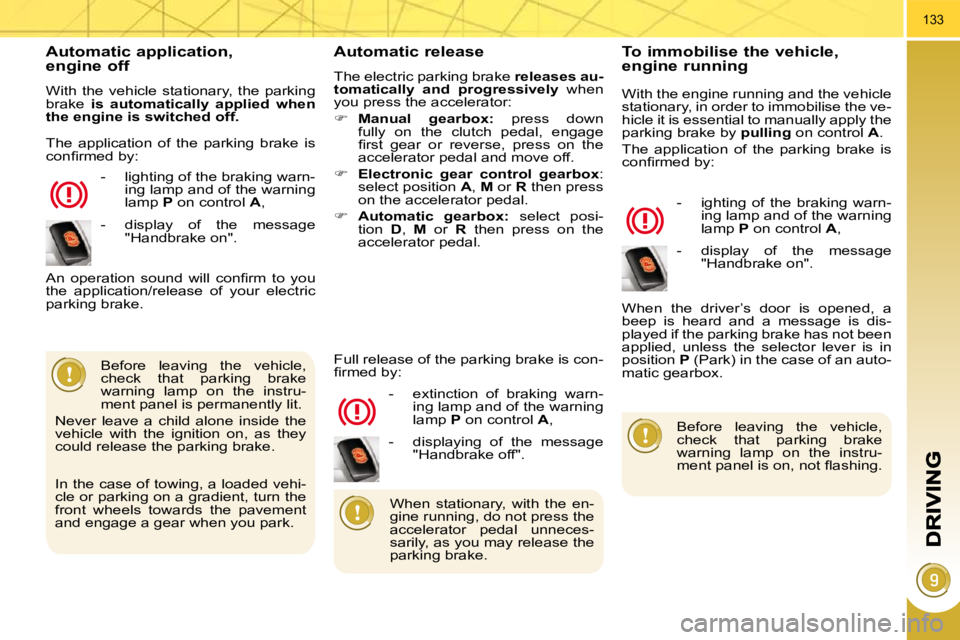
133
Automatic application, engine off
With the vehicle stationary, the parking
brake is automatically applied when
the engine is switched off.
- lighting of the braking warn- ing lamp and of the warning
lamp P on control A ,
Automatic release
The electric parking brake releases au-
tomatically and progressively when
you press the accelerator:
� Manual gearbox: press down
fully on the clutch pedal, engage
�fi� �r�s�t� �g�e�a�r� �o�r� �r�e�v�e�r�s�e�,� �p�r�e�s�s� �o�n� �t�h�e�
accelerator pedal and move off.
� Electronic gear control gearbox :
select position A , M or R then press
on the accelerator pedal.
� Automatic gearbox: select posi-
tion D , M or R then press on the
accelerator pedal.
Before leaving the vehicle,
check that parking brake
warning lamp on the instru-
ment panel is permanently lit.
Never leave a child alone inside the
vehicle with the ignition on, as they
could release the parking brake. - extinction of braking warn-
ing lamp and of the warning
lamp P on control A ,
� �A�n� �o�p�e�r�a�t�i�o�n� �s�o�u�n�d� �w�i�l�l� �c�o�n�fi� �r�m� �t�o� �y�o�u�
the application/release of your electric
parking brake.
Full release of the parking brake is con-
�fi� �r�m�e�d� �b�y�:�
To immobilise the vehicle, engine running
With the engine running and the vehicle
stationary, in order to immobilise the ve-
hicle it is essential to manually apply the
parking brake by pulling on control A .
The application of the parking brake is
�c�o�n�fi� �r�m�e�d� �b�y�:�
- ighting of the braking warn-ing lamp and of the warning
lamp P on control A ,
When the driver’s door is opened, a
beep is heard and a message is dis-
played if the parking brake has not been
applied, unless the selector lever is in
position P (Park) in the case of an auto-
matic gearbox.
Before leaving the vehicle,
check that parking brake
warning lamp on the instru-
�m�e�n�t� �p�a�n�e�l� �i�s� �o�n�,� �n�o�t� �fl� �a�s�h�i�n�g�.� � �
When stationary, with the en-
gine running, do not press the
accelerator pedal unneces-
sarily, as you may release the
parking brake.
The application of the parking brake is
�c�o�n�fi� �r�m�e�d� �b�y�:�
- display of the message "Handbrake on".
In the case of towing, a loaded vehi-
cle or parking on a gradient, turn the
front wheels towards the pavement
and engage a gear when you park. - displaying of the message
"Handbrake off". - display of the message
"Handbrake on".
Page 189 of 315
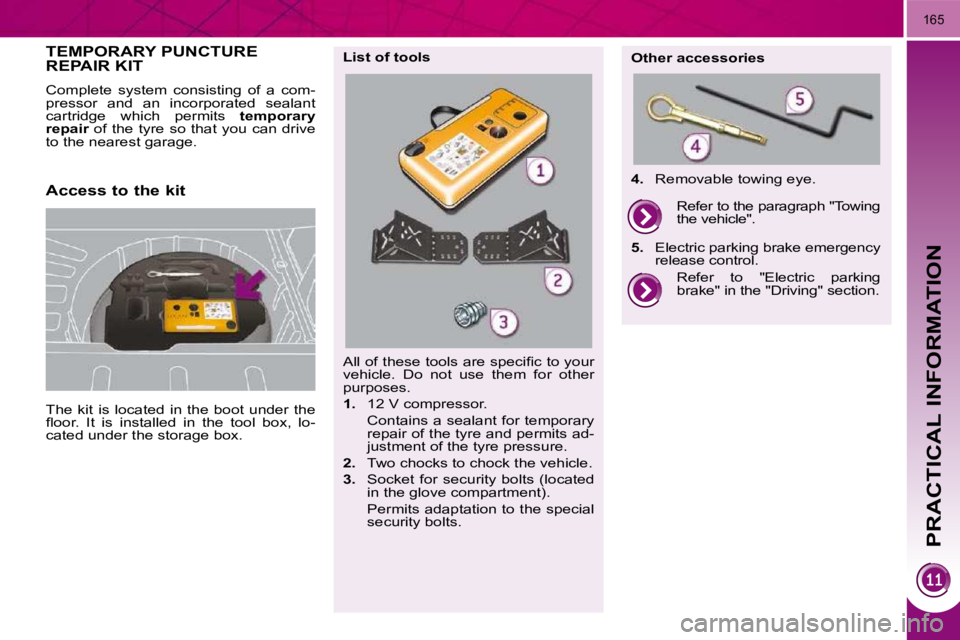
PRACTICAL INFORMATION
165
TEMPORARY PUNCTURE REPAIR KIT
The kit is located in the boot under the
�fl� �o�o�r�.� �I�t� �i�s� �i�n�s�t�a�l�l�e�d� �i�n� �t�h�e� �t�o�o�l� �b�o�x�,� �l�o�-
�c�a�t�e�d� �u�n�d�e�r� �t�h�e� �s�t�o�r�a�g�e� �b�o�x�.�
� �C�o�m�p�l�e�t�e� �s�y�s�t�e�m� �c�o�n�s�i�s�t�i�n�g� �o�f� �a� �c�o�m�-
pressor and an incorporated sealant
cartridge which permits
temporary
repair of the tyre so that you can drive
�t�o� �t�h�e� �n�e�a�r�e�s�t� �g�a�r�a�g�e�.�
� �A�l�l� �o�f� �t�h�e�s�e� �t�o�o�l�s� �a�r�e� �s�p�e�c�i�fi� �c� �t�o� �y�o�u�r�
�v�e�h�i�c�l�e�.� �D�o� �n�o�t� �u�s�e� �t�h�e�m� �f�o�r� �o�t�h�e�r�
�p�u�r�p�o�s�e�s�.�
1. � � �1�2� �V� �c�o�m�p�r�e�s�s�o�r�.� �
Contains a sealant for temporary �r�e�p�a�i�r� �o�f� �t�h�e� �t�y�r�e� �a�n�d� �p�e�r�m�i�t�s� �a�d�-
�j�u�s�t�m�e�n�t� �o�f� �t�h�e� �t�y�r�e� �p�r�e�s�s�u�r�e�.�
2. � � �T�w�o� �c�h�o�c�k�s� �t�o� �c�h�o�c�k� �t�h�e� �v�e�h�i�c�l�e�.�
3. Socket for security bolts (located
�i�n� �t�h�e� �g�l�o�v�e� �c�o�m�p�a�r�t�m�e�n�t�)�.� �
Permits adaptation to the special �s�e�c�u�r�i�t�y� �b�o�l�t�s�.� � �
List of tools
Other accessories
4. �R�e�m�o�v�a�b�l�e� �t�o�w�i�n�g� �e�y�e�.�
Refer to "Electric parking
�b�r�a�k�e�"� �i�n� �t�h�e� �"�D�r�i�v�i�n�g�"� �s�e�c�t�i�o�n�.� � �
Refer to the paragraph "Towing
�t�h�e� �v�e�h�i�c�l�e�"�.�
5. Electric parking brake emergency
�r�e�l�e�a�s�e� �c�o�n�t�r�o�l�.�
Access to the kit